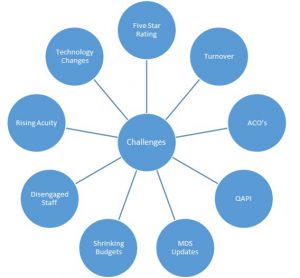These are tough times for senior living organizations. New regulations, changing payment models, and a hyper-competitive environment mean executives need both a strong, focused vision for the future of their organization and an aligned, engaged workforce able to carry out strategic objectives.
But getting there can be a challenge:
- Senior leaders can get stuck in the weeds and end up micromanaging initiatives without enough knowledge or context of the local conditions.
- Managers and front-line supervisors often don’t know or understand larger strategic needs and can get caught up in maintaining the day-to-day operations without an eye to the future.
- Lastly, line staff usually aren’t clear on how their work connects to larger objectives, and typically receive mixed messages like “we want you to innovate,” but “follow processes and procedures exactly or risk disciplinary action.”

With such mixed messages and unaligned efforts, many times organization feel like they make “two steps forward, one step back” in meeting goals, with challenges like staffing, turnover, survey compliance and resident satisfaction that is always looming on the horizon.
To move forward, apply strategy to your organization:
- Start with “why.” Align the entire organization around purpose and company values. Make sure you have a clear answer to the question “Why are we doing this work?”
- Next, develop the overall vision (“What are we doing?), based on the mission of the organization.
- Working with mid-level managers, jointly develop goals and objectives (“Where are we going?”), based on the vision.
- Mid-level managers should then be tasked with developing tactical plans (“How will we get there?”), based on goals.
- Mid-level managers and line staff develop measures (“How will we know when we get there?), based on the tactical plans.
- Line staff develop and execute implementation plans (“What work do we need to accomplish to get there?), based on measures.
The Job of the Leader

Just because your organization now has a strategic plan doesn’t mean the job of leaders is done. Continue to speak frequently and clearly about the organization’s vision and key goals. Share its relevance with employees in a way that makes them care about the organization and about the job they do. It should be at the core of all of your communications, a simple and inspiring message that is easy to relate to and understand. Strategy-specific messages linked to your purpose become tools to help employees connect their work to the larger picture.
Leaders must also monitor progress towards goals and look for opportunities to support staff and managers in their work. Communication must be two-way, too! It’s easy for leaders to send out memos and hold meetings, but to build engagement, dialogue is crucial. This helps employees build ownership over key tactical plans and provides a clear channel to communicate barriers and request help when needed.
Use stories whenever possible to highlight success and keep the team energized. Don’t talk about serving all residents—talk about serving each resident, and use specific stories to demonstrate progress. Ask employees to share stories as well, and use these as the foundation for encouraging others. Collectively, these stories and conversations will build a positive culture centered on your core purpose and strategic goals.
Charting a successful course through the rapidly shifting healthcare landscape will not be easy. The pace of change is not slowing down and there are new challenges waiting around every corner. But with a clear purpose, an aligned and engaged team, and a well-deployed strategy, your organization will be primed for success ahead.
This article was written by staff member Sean Carey.
